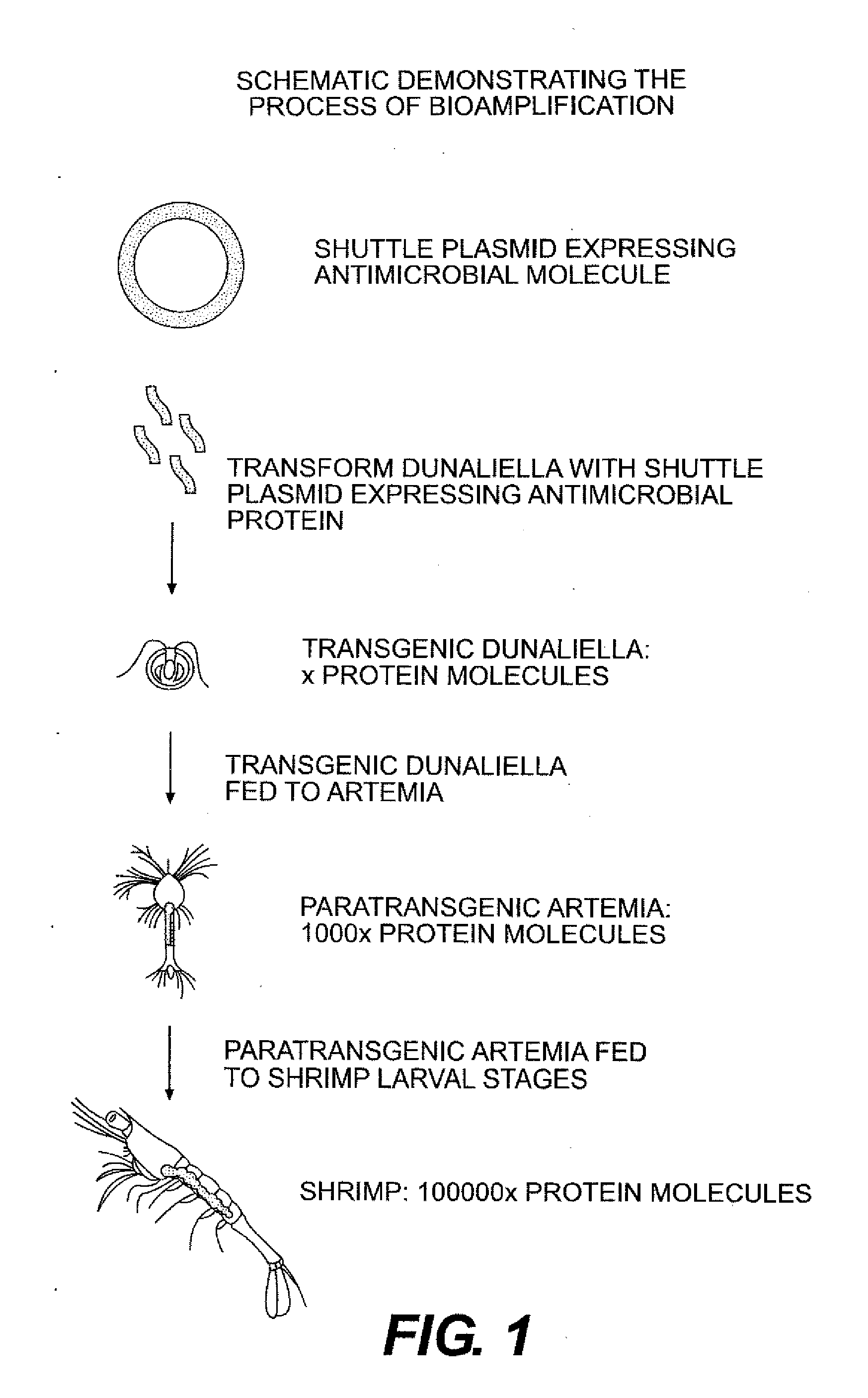Methods and Compositions for control of disease in aquaculture
a technology for aquaculture and compositions, applied in the field of methods and compositions for the control of infections in aquaculture, can solve the problems of affecting the health of fish, and affecting the production of fish, so as to achieve the effect of preventing, reducing or treating a diseas
- Summary
- Abstract
- Description
- Claims
- Application Information
AI Technical Summary
Problems solved by technology
Method used
Image
Examples
example 1
Transformation of Dunaliella
[0144]This example demonstrates the use of Dunaliella for paratransgenic control of infectious diseases of farmed shrimp. Paratransgenesis is a strategy that employs commensal or symbiotic organisms to express molecules that interfere with transmission cycles of infectious pathogens. Application of paratransgenesis to viral and bacterial diseases of farmed shrimp has been described with genetically modified cyanobacteria as the delivery agents. Here, a transformation system for Dunaliella and a framework for application of engineered Dunaliella in commercial mariculture are presented.
[0145]D. salina was transformed carrying a construct that contains the chloramphenicol acetyltransferase (CAT) gene as well as the gene that encodes for green fluorescent protein (GFP). Using GFP as a marker, we fed the transformed Dunaliella as a slurry to shrimp nauplii and monitor the progression of the GFP within the gut. This study demonstrated successful delivery of a ...
example 2
Transgenic Microorganism Expressing Antibody Fragments
[0147]Lines of marine cyanobacteria, algae and diatoms—common components of feed for farmed shrimp and fish—were transformed to produce antibodies that neutralize infectious pathogens such as WSSV and Vibrio. Delivery of these feed organisms, either in slurry preparations or via a bioamplification strategy with Artemia, results in passive immunization of the alimentary tract of farmed marine animals.
[0148]This is the portal of entry for many infectious agents and the delivery of neutralizing antibodies would either abort the infectious process or delay it sufficiently to permit harvest. We have demonstrated that a marine cyanobacterium, Synechococcus bacillarus, was genetically transformed to express a functional recombinant antibody (Durvasula et al. 2006, incorporated herein by reference in its entirety). S. bacillarus was transformed to produce a murine antibody (rDB3) against progesterone, using a heterologous expression syst...
example 3
Bioamplification of Foreign Gene Products Through Transgenic Micro algae
[0149]An alternate strategy for delivery of transgenic Dunaliella to the target animal is via bioamplification. In this strategy a feed organism such as Artemia initially consumes the transgenic Dunaliella. The engorged Artemia is then fed to the target animal. In this manner, the supplement is bioamplified as it progresses up the food-chain. Artemia are non-selective filter feeders and therefore will ingest a wide range of foods. The main criteria for food selection are particle size, digestibility, and nutrient levels. (Dobbeleir et al. 1980). Possibly the best foods for Artemia are live micro algae such as Nannochloropsis, Tetraselmis, Isochrysis, Dunaliella and Pavlova. Combinations of live phytoplanktons fed to Artemia cultures have demonstrated superior enrichment characteristics over feeding single phytoplankton species (D'Agostino 1980). However, not all species of unicellular algae are appropriate for s...
PUM
| Property | Measurement | Unit |
|---|---|---|
| binding constant | aaaaa | aaaaa |
| density | aaaaa | aaaaa |
| resistance | aaaaa | aaaaa |
Abstract
Description
Claims
Application Information
 Login to View More
Login to View More - R&D Engineer
- R&D Manager
- IP Professional
- Industry Leading Data Capabilities
- Powerful AI technology
- Patent DNA Extraction
Browse by: Latest US Patents, China's latest patents, Technical Efficacy Thesaurus, Application Domain, Technology Topic, Popular Technical Reports.
© 2024 PatSnap. All rights reserved.Legal|Privacy policy|Modern Slavery Act Transparency Statement|Sitemap|About US| Contact US: help@patsnap.com









